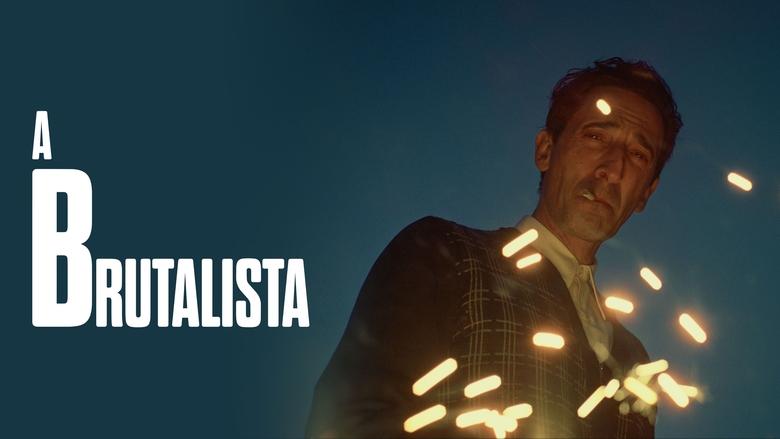Overview
Escaping post-war Europe, visionary architect László Toth arrives in America to rebuild his life, his work, and his marriage to his wife Erzsébet after being forced apart during wartime by shifting borders and regimes. On his own in a strange new country, László settles in Pennsylvania, where the wealthy and prominent industrialist Harrison Lee Van Buren recognizes his talent for building. But power and legacy come at a heavy cost.
Introduction to “The Brutalist”
“The Brutalist” is a 2020 drama film that has garnered significant attention for its compelling narrative and powerful performances. Directed by Brady Corbet, the movie delves into the life of an architect who moves to America after World War II, aiming to rebuild his life and career. The film is a poignant exploration of ambition, loss, and the human spirit’s resilience. With a runtime of 127 minutes, “The Brutalist” offers a rich, immersive experience that lingers long after the credits roll. The movie has been praised for its meticulous attention to detail and its ability to capture the essence of post-war America. If you’re a fan of thought-provoking cinema, this is a film you won’t want to miss.
Plot Overview
The story of “The Brutalist” revolves around the protagonist, an architect played by Joel Edgerton, who flees Europe after the devastation of World War II. Settling in America, he seeks to start anew, both personally and professionally. The film chronicles his journey as he navigates the challenges of rebuilding his life, dealing with personal loss, and striving to leave a lasting legacy through his work. The narrative is interwoven with flashbacks that provide insight into his past, adding depth to his character and motivations. As the architect’s career begins to flourish, he is confronted with moral dilemmas and the harsh realities of the world around him. The film’s plot is a masterful blend of historical context and personal drama, making it a compelling watch from start to finish.
Cast and Performances
The cast of “The Brutalist” is nothing short of stellar, with Joel Edgerton delivering a standout performance as the lead character. His portrayal of the architect is nuanced and deeply emotional, capturing the complexities of a man torn between his past and his aspirations. Supporting roles by Marion Cotillard and Sebastian Stan further elevate the film, with each actor bringing their A-game to the table. Cotillard’s performance as the architect’s wife is particularly noteworthy, adding layers of emotional depth to the narrative. Stan, on the other hand, plays a pivotal role that adds tension and intrigue to the story. The chemistry between the cast members is palpable, making their interactions feel authentic and engaging. Overall, the performances in “The Brutalist” are a testament to the talent and dedication of its cast.
Direction and Cinematography
Brady Corbet’s direction in “The Brutalist” is nothing short of masterful. His ability to weave a complex narrative with such clarity and emotional resonance is commendable. The film’s cinematography, helmed by Lol Crawley, is equally impressive, with each frame meticulously composed to reflect the mood and tone of the story. The use of lighting and color palettes effectively conveys the passage of time and the emotional states of the characters. The architectural elements in the film are captured with a keen eye for detail, highlighting the protagonist’s passion and dedication to his craft. The visual storytelling in “The Brutalist” is a key component of its success, drawing viewers into its world and keeping them engaged throughout. Corbet’s vision, combined with Crawley’s cinematography, creates a cinematic experience that is both visually stunning and emotionally impactful.
Themes and Symbolism
“The Brutalist” is rich with themes and symbolism that add layers of meaning to the narrative. The film explores the concept of rebuilding, both in a literal and metaphorical sense, as the protagonist seeks to reconstruct his life and career. The architectural elements in the story serve as a metaphor for the human condition, reflecting the struggles and triumphs of the characters. The film also delves into themes of loss, resilience, and the pursuit of legacy, offering a poignant commentary on the human experience. The use of flashbacks and nonlinear storytelling adds depth to the narrative, allowing viewers to piece together the protagonist’s journey and understand his motivations. The symbolism in “The Brutalist” is subtle yet powerful, inviting viewers to engage with the film on a deeper level and uncover its many layers of meaning.
Why You Should Watch “The Brutalist”
If you’re a fan of thought-provoking cinema, “The Brutalist” is a film that should be on your must-watch list. The movie offers a rich, immersive experience that combines a compelling narrative with powerful performances and stunning visuals. The film’s exploration of themes such as resilience, loss, and the pursuit of legacy is both poignant and relatable, making it a deeply emotional watch. The direction and cinematography are top-notch, creating a cinematic experience that is both visually stunning and emotionally impactful. Whether you’re a fan of historical dramas or character-driven stories, “The Brutalist” has something to offer. The film’s ability to capture the essence of post-war America and the human spirit’s resilience is truly remarkable, making it a standout in the genre. Don’t miss out on this 2020 masterpiece.
The Historical Context of “The Brutalist”
“The Brutalist” is set in the aftermath of World War II, a period marked by significant social and economic changes. The film captures the essence of this era, portraying the struggles and aspirations of those who sought to rebuild their lives in a new world. The protagonist’s journey is emblematic of the broader experiences of many who fled Europe in search of a better future. The film’s attention to historical detail is commendable, offering viewers a glimpse into the challenges and opportunities of post-war America. The historical context adds depth to the narrative, making it not just a personal story but also a reflection of a pivotal moment in history. For history enthusiasts, “The Brutalist” provides a fascinating look at the intersection of personal and historical narratives.
The Role of Architecture in “The Brutalist”
Architecture plays a central role in “The Brutalist,” serving as both a backdrop and a metaphor for the protagonist’s journey. The film explores the idea of architecture as a means of expression and legacy, reflecting the protagonist’s desire to leave a lasting impact on the world. The architectural elements in the film are meticulously designed, showcasing the protagonist’s passion and dedication to his craft. The use of architecture as a metaphor for rebuilding and resilience adds layers of meaning to the narrative, making it a rich and thought-provoking experience. The film’s portrayal of architecture is not just about buildings but also about the human spirit’s ability to create and endure. For those interested in architecture, “The Brutalist” offers a unique and inspiring perspective on the art form.
The Emotional Depth of “The Brutalist”
One of the standout features of “The Brutalist” is its emotional depth. The film delves into the complexities of human emotions, exploring themes of loss, love, and resilience. The protagonist’s journey is marked by moments of profound sadness and joy, capturing the full spectrum of the human experience. The film’s ability to evoke such strong emotions is a testament to its powerful storytelling and performances. The emotional depth of “The Brutalist” makes it a deeply moving and relatable experience, resonating with viewers on a personal level. Whether you’re drawn to stories of personal struggle or tales of triumph, “The Brutalist” offers a rich and emotionally satisfying narrative that will stay with you long after the credits roll.
The Cinematic Techniques in “The Brutalist”
“The Brutalist” employs a range of cinematic techniques to enhance its storytelling. The use of flashbacks and nonlinear narrative structures adds depth and complexity to the story, allowing viewers to piece together the protagonist’s journey. The film’s cinematography is visually stunning, with each frame carefully composed to reflect the mood and tone of the narrative. The use of lighting and color palettes effectively conveys the passage of time and the emotional states of the characters. The film’s sound design and score also play a crucial role in creating an immersive experience, drawing viewers into the world of “The Brutalist.” These cinematic techniques work together to create a rich and engaging narrative that is both visually and emotionally impactful.
The Legacy of “The Brutalist”
“The Brutalist” is a film that leaves a lasting impression, both in terms of its narrative and its themes. The film’s exploration of legacy and the human desire to leave a mark on the world is both poignant and thought-provoking. The protagonist’s journey is a testament to the power of resilience and the enduring human spirit. The film’s legacy is its power to inspire and move viewers. It offers a strong message about the human experience. “The Brutalist” is not just a film but a reflection on what it means to live a meaningful life. Its themes of rebuilding, strength, and legacy connect with many people. This makes it a film that will be remembered and talked about for years
The Critical Reception of “The Brutalist”
“The Brutalist” has received widespread critical acclaim for its powerful storytelling, stunning visuals, and exceptional performances. Critics have praised the film for showing what post-war America was like. They also liked its deep themes. The film’s direction, cinematography, and performances have been highlighted as standout elements, contributing to its overall success. The reviews of “The Brutalist” show that it is a must-watch film. Fans of deep cinema will enjoy it. The film’s ability to resonate with both critics and audiences alike is a testament to its quality and impact. If you want a movie that has both strong emotions and smart ideas, “The Brutalist” is a great choice
The Cultural Impact of “The Brutalist”
“The Brutalist” has made a significant cultural impact, sparking discussions about its themes and messages. The film’s exploration of post-war America and the human spirit’s resilience has resonated with audiences, offering a powerful commentary on the human experience. The film’s portrayal of architecture and its role in shaping our world has also sparked interest and debate. “The Brutalist” has become a cultural touchstone, inspiring discussions about legacy, resilience, and the power of art. The film’s impact extends beyond the screen, influencing conversations about history, architecture, and the human condition. For those who care about art and culture, “The Brutalist” provides a deep and interesting experience
The Music and Sound Design of “The Brutalist”
The music and sound design of “The Brutalist” are very important. They help create an immersive and emotional experience. The film’s score, composed by Scott Walker, is hauntingly beautiful, perfectly complementing the narrative’s tone and mood. The use of sound design enhances the film’s visual storytelling, drawing viewers into the world of “The Brutalist.” The music and sound design work together. They create a rich and engaging experience for the ears. This adds depth and dimension to the film. The film’s soundscape is a key component of its success, contributing to its overall impact and emotional resonance. For those who value music and sound in film, “The Brutalist” provides a great lesson in storytelling through sound
The Visual Aesthetics of “The Brutalist”
The visual aesthetics of “The Brutalist” are a standout feature, contributing to the film’s overall impact and appeal. The film’s cinematography, led by Lol Crawley, is visually stunning. Each frame is carefully composed to show the mood and tone of the story. Lighting and color choices show the passage of time and the feelings of the characters. The film shows architectural details very well. This highlights the main character’s passion and dedication to his work. The visual storytelling in “The Brutalist” is a big part of its success. It pulls viewers into its world and keeps them engaged. The film’s visual aesthetics are a testament to the talent and dedication of its creative team.
The Writing and Screenplay
The writing and screenplay of “The Brutalist” are important for its success. They help create strong storytelling and deep emotions. The film’s screenplay, by Brady Corbet and Mona Fastvold, skillfully mixes history and personal drama. The dialogue is sharp and poignant, capturing the complexities of the characters and their relationships. The film’s narrative structure, which includes flashbacks and nonlinear storytelling, adds depth and complexity to the story. The writing in “The Brutalist” shows the skill and hard work of its writers. It provides a rich and engaging story that connects with viewers. For those who appreciate well-crafted screenplays, “The Brutalist” is a standout example of the art form.
The Character Development in
The character development in “The Brutalist” is a standout feature, contributing to the film’s emotional depth and impact. The protagonist’s journey is marked by significant growth and transformation, reflecting the complexities of the human experience. The supporting characters are equally well-developed, adding depth and dimension to the narrative. The film’s ability to create such rich and relatable characters is a testament to its powerful storytelling and performances. The character development in “The Brutalist” is important for its success. It draws viewers into the story and keeps them engaged. For those who appreciate character-driven narratives, “The Brutalist” offers a rich and satisfying experience.
The Symbolism of Rebuilding
The idea of rebuilding is a key theme in “The Brutalist.” It shows the main character’s journey and the film’s historical background. The idea of rebuilding is explored in both a literal and metaphorical way. This offers a strong commentary on the human experience. The buildings in the film represent the main character’s wish to create and leave a lasting legacy. The symbolism of rebuilding adds layers of meaning to the narrative, making it a rich and thought-provoking experience. The film explores this theme in a touching and inspiring way. It connects with viewers on a deep, personal level. For those interested in the symbolism of art and architecture, “The Brutalist” offers a unique and compelling perspective.
The Influence of Post-War America
The impact of post-war America is important in “The Brutalist.” It shapes the story and the main character’s journey. The film shows the spirit of this time. It highlights the struggles and hopes of people trying to rebuild their lives in a new world. The historical context adds depth to the story. It is not just a personal tale but also shows an important moment in history. The film shows post-war America in a true and powerful way. It gives viewers a look at the challenges and chances of that time. For history lovers, “The Brutalist” offers an interesting view of personal and historical stories. It creates a rich and engaging experience
The Emotional Resonance
The emotional impact of “The Brutalist” is one of its strongest features. It creates a deeply moving and relatable experience. The film explores themes like loss, love, and resilience. These themes connect with viewers personally, stirring strong emotions and thoughts. The main character’s journey includes deep sadness and joy. It shows the wide range of human experiences. The film’s ability to evoke such strong emotions is a testament to its powerful storytelling and performances. The emotional impact of “The Brutalist” makes it a film that lingers after the credits end. It offers a rich story that is both thought-provoking and inspiring


